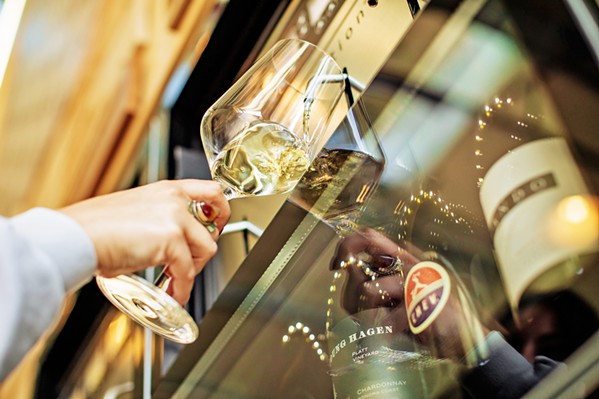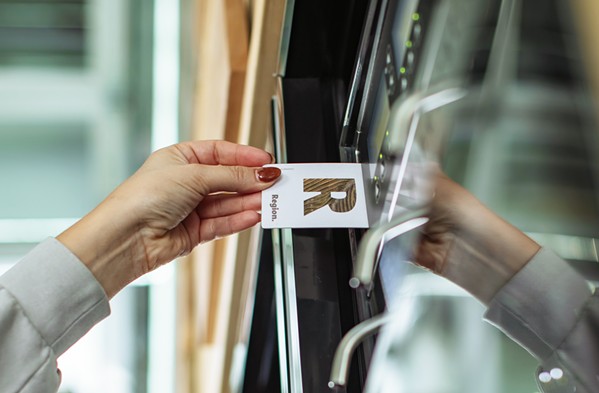It's hard for sunshine not to stream into Region Wine Bar's downtown San Luis Obispo space. A large archway welcomes the light along with visitors eager to sip local wines. But while the sunbeams fall on the wine bar's jade-toned counters and plush cream-colored sofas, all eyes land on the row of sleek wine coolers with four dispenser nozzles sprouting out of each of them.
One by one, customers grabbed a wine glass from the wall, inserted a white card bearing the letter 'R' into the cooler, pressed a button, and slid their glass under the dispenser. Seconds later, ruby red wine poured out of the WineStation, much to everyone's amusement on June 17.
"It puts the control and power of the wine tasting experience in the hands of the consumer. We have people that want to come in and send an email after work and have a glass of wine and no one's going to bug you, all the way up to Google executives that want to know every clone that's in the pinot and have an elevated experience," Region co-founder Johan Eide said. "We can hit both of those, which is really unique in a wine bar. We feel approachable but we can back it up with wine knowledge."
Region debuted in June 2020 when Eide and his co-founder, Kerry Thedorf, opened the first bar in Sebastopol, Sonoma County. After riding through the pandemic and forest fires, the duo opened the Downtown SLO counterpart in April 2022.
Eide described Region as a bridge that connects wine makers and drinkers—and its brand name stems from the company being "a hub to a region through wine."

- Photo Courtesy Of Region Wine Bar
- POURS APLENTY Early types of wine self-serve stations first appeared in Europe, but those machines faced hygiene complaints. Johan Eide of Region SLO credited Napa Technology, which created WineStations, with revamping wine dispensers.
Region SLO collaborated with 25 wineries that all promote it as their go-to tasting room because most of them are small production vintners that don't have their own tasting rooms. Each week, one of them becomes Region's featured winery of the week and receives full creative liberty on how to show off their wines. Eide said that this could look like hosting pickup parties and pairing events or offering a featured wine flight on the menu. On June 17, Region was spotlighting Paso Robles-based dilécta winery and recommended the 2019 Phoenix—a sweet and bubbly blanc de noir, a perfect pairing with the sunny patio.
Wineries like dilécta showcase the diversity of SLO County's myriad American Viticulture Areas (AVA), Eide said. He then pointed to an earth-toned contemporary map of SLO County's AVAs that hangs on the wine bar's wall.
"A county or wine-growing region is typically broken into AVAs. Essentially, the climate or terrain is so different that it's going to produce a very distinct wine," Eide added. "We're technically in the SLO Coast, which just got approved this year [as an AVA], which is a big milestone for SLO. Just going from here, up the grade to Atascadero, Santa Margarita, Creston, Highlands District ... it's night and day. There is a nocturnal 20 degree difference every night."
Eide then moved his hand to the right, gesturing toward the distinctive self-serving stations, the first iterations of which appeared in bars in Europe. At Region, customers get a card with an open line of credit that they swipe to get served. The WineStations then dole out 1-ounce tasters, half glass measures of 2.5 ounces, and full 5-ounce pours. Cost ranges from $2.50 to $15, depending on the bottle and the pour size. Soon, the machines will also bear NFC tags so that customers can easily scan the code with their phones and learn about the wineries.
"I call it the froyo shop for adults!" Bailey Matthews, a Region wine guide and fourth-year viticulture student at Cal Poly, said with a laugh.
Matthews is one of Region SLO's 13 staff members who get front-seat lessons on wine thanks to company policy.
"We pay for all of our staff to visit our wineries. We believe in educating our staff. They go to see firsthand who the winemaker is, where they source the fruit. When they're here in store, they're not memorizing tasting notes," Eide said. "It makes this personal connection that wine is so much about. It's the No. 1 thing people bring to parties. If they can feel that they're part of something cool or hard to find or special, we've done our job. There's so much authenticity here that just doesn't have a platform in SLO."
Currently, Region is working with hospitality partners to add food to the wine menu. Unlike a traditional restaurant, Region sells wines for the same price that's offered at the wineries themselves, with proceeds going back to them.
Eide, with his roots in mechanical engineering and winemaking as a hobby, wanted to close the gap in the wine industry that disadvantages small-production wineries.
"It's really, really hard to compete with very large producers that can have a $5 million tasting room, a lot of ads spent, a free flight if you come visit their winery. Each winery is trying to keep you there longer and longer for the tasting experience. Here, we're trying to get that middle ground. They pay us a monthly fee, and it's a minimal fraction of what the cost would have been to pull this off themselves, but they all get the same exposure," he said.

- Photo Courtesy Of Region Wine Bar
- TAP IN Region's customers can choose different pour sizes from 50 rotating wines, all with the swipe of a tasting room card with an open credit line.
Eide is noticing changes to the market and customer behavior—from the customer demographic morphing into a younger, college-age crowd searching for a grander drinking experience, to the slow dismantling of the old guard.
"For me, the No. 1 thing that stood out was in Sonoma County, before COVID, seven years in a row, tasting room visitations were down but tourism was up. Today's customers aren't identifying with the traditional tasting room experience. So, how do we bring the wine to the customer and where they're frequenting, and still keep that intimacy?" Eide said. "I think the tasting room still has its place, but the traditional thought of, 'My family's last name and my tasting room is going to sell my line,' isn't cutting it anymore." Δ
If you can't find Staff Writer Bulbul Rajagopal by the WineStation dispenser, reach her at [email protected].

Comments
Showing 1-1 of 1